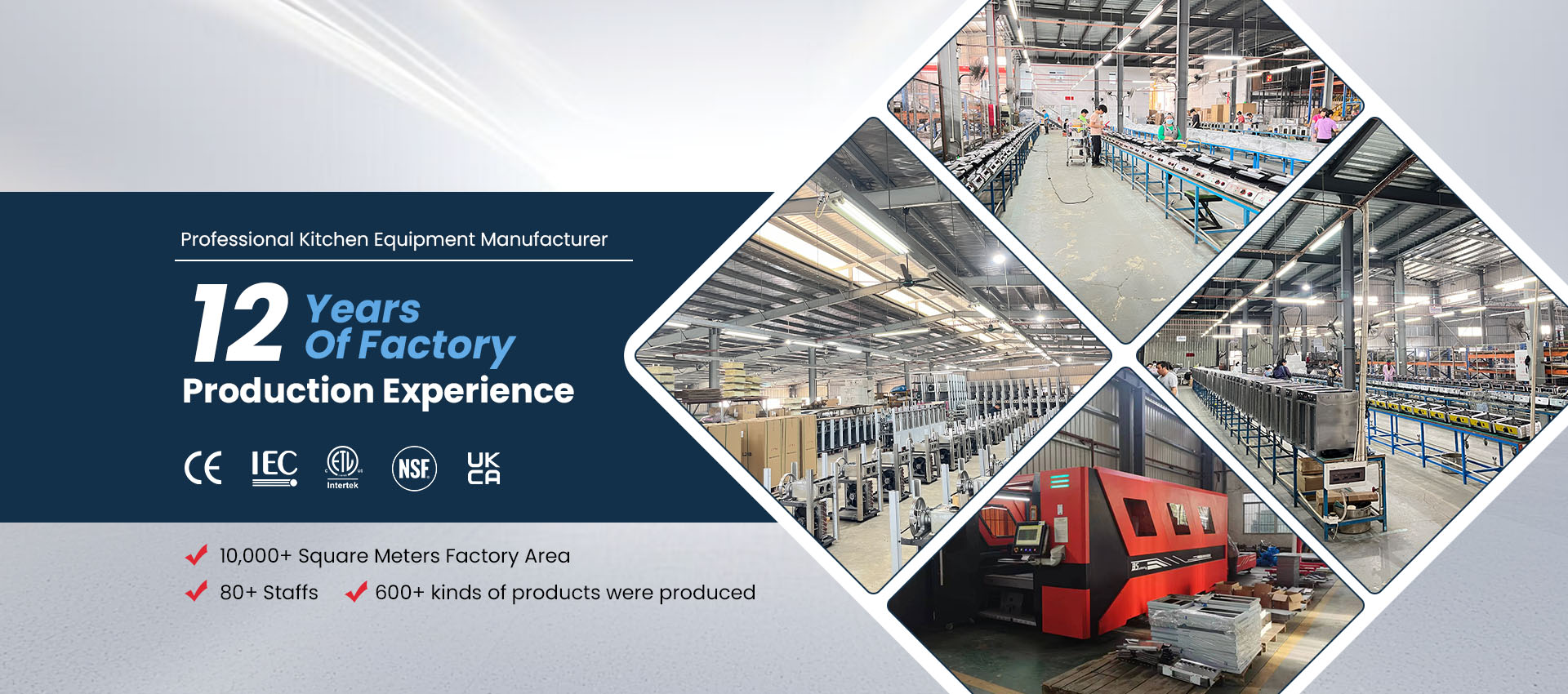How Does A Gas Fryer Work
A Gas Fryer is one of the most essential pieces of equipment in any commercial kitchen. It provides fast, consistent heating for deep-frying foods such as French fries, chicken, seafood, and pastries. Understanding how a gas fryer works helps you use it efficiently, maintain safety, and get better cooking results.
This article explains the working principle of a gas fryer, its main components, heating process, and why MLP Kitchen Equipment, a professional manufacturer of commercial fryers, designs energy-efficient models that deliver consistent performance for global foodservice operations.
1. Basic Principle of a Gas Fryer
A gas fryer works by burning natural gas (NG) or liquefied petroleum gas (LPG) to heat oil in a tank. The heat transfers from gas burners through the metal walls of the fry pot, raising the oil to the desired cooking temperature — typically between 160°C and 190°C (320°F–375°F).
Once the oil reaches the set temperature, food is submerged in the oil to cook quickly and evenly. The fryer maintains temperature automatically through a thermostat control system, cycling the burner flame on and off as needed.
In short, a gas fryer converts gas energy into heat energy for deep-frying while maintaining stable and efficient temperature control.
2. Main Components of a Gas Fryer
Every commercial gas fryer is built with a few key components that work together to heat and regulate the oil.
| Component | Function |
|---|---|
| Fry Pot / Oil Tank | Holds the cooking oil and transfers heat from burners to oil |
| Gas Burners | Produce flame to heat the oil quickly and evenly |
| Thermostat / Control Knob | Regulates temperature and prevents overheating |
| Gas Valve | Controls the flow of gas to the burners |
| Ignition System | Lights the gas burners (manual pilot or electronic ignition) |
| Flue / Exhaust | Releases combustion gases safely |
| Safety Shutoff System | Stops gas flow if the flame goes out or oil overheats |
| Fryer Basket | Holds food and allows safe immersion into hot oil |
Each part plays an important role in maintaining consistent frying results while keeping the operation safe.
3. Step-by-Step: How a Gas Fryer Works
Let’s look at the typical operating cycle of a commercial gas fryer:
Step 1: Ignition
The process begins when you ignite the burners. Depending on the model, ignition may occur by:
Manual pilot flame: A small continuous flame lights the main burners when the gas valve opens.
Electronic ignition: A spark system ignites the burners automatically when you switch on the fryer.
Step 2: Gas Combustion
Once ignited, gas mixes with air and burns in the burner tubes. The flames generate intense heat that transfers to the fry pot.
Step 3: Oil Heating
The fry pot — usually made of stainless steel — absorbs heat from the burner flames or heat-exchange tubes beneath it. The oil heats evenly throughout the tank.
As the oil reaches the set temperature, the thermostat signals the gas valve to reduce or cut off the flame.
Step 4: Frying Process
When you lower food into the oil, the temperature temporarily drops. The thermostat detects this change and reignites the burners to restore the desired temperature quickly.
This automatic cycling continues throughout cooking to maintain steady heat, ensuring food cooks evenly and absorbs less oil.
Step 5: Exhaust and Ventilation
Combustion gases exit through the flue at the back of the fryer. Proper ventilation ensures safety and prevents heat accumulation in the kitchen.
4. Types of Gas Fryer Heating Systems
There are two main heating designs for commercial gas fryers: tube-type and open-pot type.
| Type | Description | Best For |
|---|---|---|
| Tube-Type Fryer | Burners heat metal tubes immersed in oil, transferring heat efficiently | High-volume frying, large kitchens |
| Open-Pot Fryer | Burners sit under the fry pot, heating the bottom surface directly | Light frying or fast-food kitchens |
Both systems are efficient, but tube-type fryers offer slightly faster recovery time and are ideal for thick, high-demand frying tasks.
5. Temperature Control System
The thermostat is one of the most critical parts of a gas fryer. It measures oil temperature and automatically controls gas flow to maintain it within the set range.
Common Control Methods
Mechanical Thermostat: Simple knob-based control used in basic models.
Digital Thermostat: Uses sensors and electronic display for precise temperature regulation.
Kangjia and MLP Kitchen Equipment gas fryers often include digital thermostats that improve frying accuracy and prevent overcooking or oil degradation.
6. Safety Features in Modern Gas Fryers
Modern gas fryers integrate multiple safety mechanisms to prevent accidents:
| Feature | Function |
|---|---|
| Thermal Limit Switch | Shuts off gas if oil exceeds safe temperature |
| Flame Failure Device | Cuts gas if flame extinguishes unexpectedly |
| Pressure Regulator | Maintains stable gas supply |
| Pilot Indicator Light | Shows when the burner is active |
| Automatic Shutoff | Stops gas flow during overheating or malfunction |
These features make commercial gas fryers both safe and reliable for high-volume kitchen operations.
7. Energy Efficiency and Maintenance
To ensure efficient heating and lower gas consumption:
Keep burners clean: Residue buildup restricts airflow and reduces flame strength.
Filter oil regularly: Clean oil heats faster and maintains quality.
Check gas connections: Secure hoses and valves prevent leaks.
Calibrate the thermostat: Ensures accurate temperature control.
MLP Kitchen Equipment designs its gas fryers with optimized burner layouts and energy-saving combustion systems, reducing gas usage while achieving quick oil recovery.
8. Gas Fryer vs. Electric Fryer: Quick Comparison
| Feature | Gas Fryer | Electric Fryer |
|---|---|---|
| Heat Source | Gas flame | Heating element |
| Heating Speed | Faster initial heating | More even heat distribution |
| Temperature Recovery | Quick | Moderate |
| Installation Needs | Gas line and ventilation | Power outlet only |
| Energy Cost | Lower in gas-based regions | Depends on electricity rates |
If you need high output and rapid recovery time, gas fryers are often the better choice.
9. Why Choose MLP Kitchen Equipment Gas Fryers
MLP Kitchen Equipment, located in Jiangmen City, Guangdong Province, China, is a trusted manufacturer specializing in commercial cooking appliances, including gas fryers, griddles, ranges, and Food Warmers.
Advantages of MLP Gas Fryers
Efficient gas burners with high heat output and low consumption.
3/4-inch standard gas connection compatible with commercial kitchen systems.
Accurate thermostatic control for consistent frying temperature.
Stainless-steel body and fry pot for durability and easy cleaning.
Safety certifications such as CE, UL, and UKCA.
OEM/ODM customization available for international buyers.
Each fryer is engineered for long-term performance, fast oil recovery, and superior energy savings — ideal for restaurants, cafes, and hotel kitchens.
10. Conclusion
A gas fryer works by burning natural gas or propane to heat oil through powerful burners. The oil then cooks food quickly and evenly, while thermostats and safety systems maintain stable operation.
Modern gas fryers often include digital temperature control, automatic ignition, and safety shutoffs, combining convenience with efficiency.
For durable, energy-saving, and easy-to-operate commercial gas fryers, MLP Kitchen Equipment provides professional solutions built to international standards — helping kitchens worldwide achieve reliable frying performance with every batch.
Previous: How Much Is A Gas Deep Fryer



